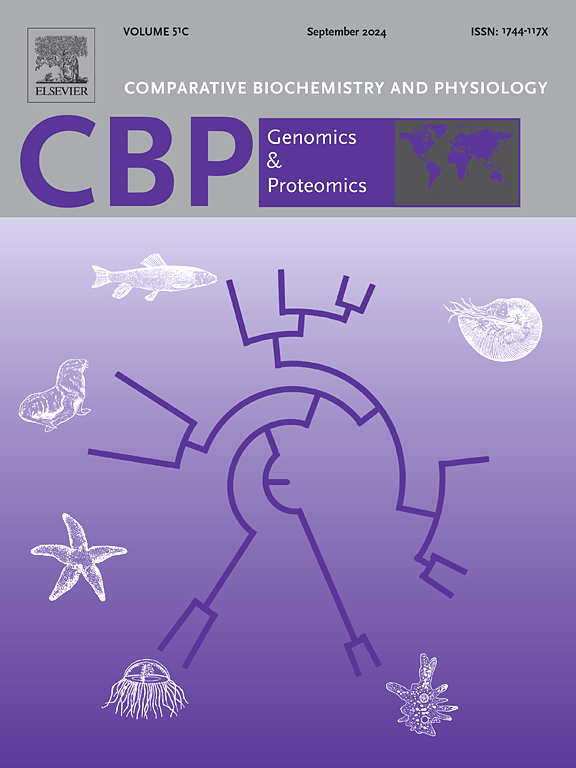温度介导的甲状腺激素诱导的蝠鲼蜕变过程中组蛋白丰度和翻译后修饰的变化
IF 2.2
2区 生物学
Q4 BIOCHEMISTRY & MOLECULAR BIOLOGY
Comparative Biochemistry and Physiology D-Genomics & Proteomics
Pub Date : 2025-04-16
DOI:10.1016/j.cbd.2025.101513
引用次数: 0
摘要
两栖动物蜕变涉及甲状腺激素(TH)依赖的胚胎后分化组织的重塑,如蝌蚪转变为青蛙。外源TH处理可使美国牛蛙(Rana [Lithobates] catesbeiana)在预变质蝌蚪中提前诱导变态。然而,变态是温度依赖性的,即使在TH处理下,也不会在5°C下发生。值得注意的是,暴露在5°C的TH中建立了一种分子记忆,当转移到允许的温度(24°C)时,这种记忆为蝌蚪加速变态做好了准备。先前的研究表明,在TH存在和不存在的情况下,组蛋白翻译后修饰(PTMs)和组蛋白变异的结合在低温暴露下发生改变。在此,我们使用质谱法分析了在允许温度(24°C)、非允许温度(5°C)和转移条件(5→24°C)下注射TH后,预变质斑胸螺血液、肝脏和尾鳍的组蛋白组成。使用严格的选择标准,我们确定了染色质结合蛋白(包括组蛋白)的丰度和推测的ptm的组织和温度特异性变化。仅在允许温度下进行TH处理后,三种组织的连接子组蛋白变异H1.0丰度均增加。甲基- cpg结合蛋白2 (MeCP2)和高迁移率组(HMG)蛋白丰度的th依赖性变化是温度和组织特异性的。在不同温度条件下,经TH处理后的ptm,包括肝脏中H3K27和H3K36甲基化的变化,含量不同。我们还发现了新发现的HMGB2甲基化标记,这些标记在TH处理后表现出温度特异性的丰度变化。这些观察结果表明,表观遗传变异可能有助于早期TH信号事件和分子记忆。本文章由计算机程序翻译,如有差异,请以英文原文为准。
![Changes in histone abundance and post-translational modifications in Rana [Lithobates] catesbeiana tissues during temperature-mediated thyroid hormone-induced metamorphosis](https://img.booksci.cn/booksciimg/2025-4/102303079581775814789.jpg)
Changes in histone abundance and post-translational modifications in Rana [Lithobates] catesbeiana tissues during temperature-mediated thyroid hormone-induced metamorphosis
Amphibian metamorphosis involves thyroid hormone (TH)-dependent postembryonic remodeling of differentiated tissues as a tadpole transforms into a frog. Rana [Lithobates] catesbeiana (American bullfrog) metamorphosis can be precociously induced in premetamorphic tadpoles by treatment with exogenous TH. However, metamorphosis is temperature-dependent and does not occur at 5 °C, even with TH treatment. Remarkably, exposure to TH at 5 °C establishes a molecular memory that primes the tadpole for an accelerated metamorphosis when shifted to a permissive temperature (24 °C). Previous research suggests that histone post-translational modifications (PTMs) and the incorporation of histone variants are altered upon cold temperature exposure in the presence and absence of TH. Herein, we use mass spectrometry to analyze the histone composition of premetamorphic R. catesbeiana blood, liver, and tailfin following TH injection at a permissive temperature (24 °C), a non-permissive temperature (5 °C), and a shifted condition (5 → 24 °C). Using stringent selection criteria, we identified tissue- and temperature-specific changes in the abundance and putative PTMs of chromatin-binding proteins, including histones. Linker histone variant H1.0 abundance increased in all three tissues following TH treatment under permissive temperatures only. TH-dependent changes in the abundance of methyl-CpG binding protein 2 (MeCP2) and high mobility group (HMG) proteins were temperature- and tissue-specific. PTMs, including variations in H3K27 and H3K36 methylations in the liver, were differentially abundant following TH treatment under the different temperature conditions. We also identified newly discovered HMGB2 methylation marks that exhibited temperature-specific changes in abundance following TH treatment. These observations suggest that epigenetic variations may contribute to early TH signaling events and to molecular memory.
求助全文
通过发布文献求助,成功后即可免费获取论文全文。
去求助
来源期刊
CiteScore
5.10
自引率
3.30%
发文量
69
审稿时长
33 days
期刊介绍:
Comparative Biochemistry & Physiology (CBP) publishes papers in comparative, environmental and evolutionary physiology.
Part D: Genomics and Proteomics (CBPD), focuses on “omics” approaches to physiology, including comparative and functional genomics, metagenomics, transcriptomics, proteomics, metabolomics, and lipidomics. Most studies employ “omics” and/or system biology to test specific hypotheses about molecular and biochemical mechanisms underlying physiological responses to the environment. We encourage papers that address fundamental questions in comparative physiology and biochemistry rather than studies with a focus that is purely technical, methodological or descriptive in nature.

 求助内容:
求助内容: 应助结果提醒方式:
应助结果提醒方式:


